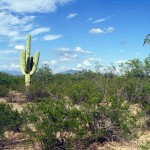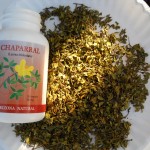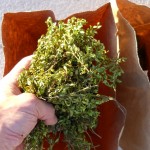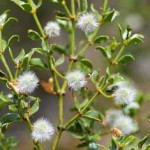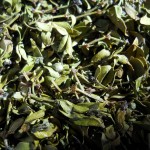CHAPARRAL
Earth Medicine
by Eddie Katz
Chaparral is very inexpensive and can be purchased in many forms
at your local health food store. I like to wild-craft Chaparral after the
Winter rains and before it goes to seed. Through my many years of using
this herb, I have found no adverse side effects. The
FDA attempted to take it off the market in the early 1990s claiming
that it caused damage to the liver. It has since been vindicated
enough to be available today. The pharmaceutical industry has long
been envious of products that grow wild in your own yard since they
cannot patent them. As long as natural, inexpensive remedies in the
form of herbs or weeds are growing around us, we need to learn how
to utilize them just as our great grand parents did.
Also Known as Greasewood, or Hediondilla
Larrea Tridentata
Chaparral is about the most powerful Herb in antioxidant, cleanser, anti-tumor agent, pain killer, and antiseptic.
Constituents
Alpha-pinene, amino acids, beta-pinene, cobalt, gossypetin, limonene, nordihydroguaiaretic acid or NDGA, zinc.
Parts Used
Build your Immune System!
Chaparral is medicinally powerful for antibacterial, antimicrobial, anti fungal, antiviral purposes.
Chaparral (Larrea Tridentata) is a prominent species in the Mojave, Sonoran, and Chihuahuan Deserts of western North America, and its range includes those and other regions in portions of California, Arizona, Nevada, Utah, New Mexico and western Texas in the United States, and northern Chihuahua and Sonora in Mexico. It is closely related to the South American Larrea divaricata and was formerly treated as the same species.
CHAPARRAL (Larrea Tridentata) Especially known for its actions with arthritis and cancer. The Native American Indians considered it a panacea. Cleansing to the lower bowel and toning to the peristaltic muscles. Considered to be a blood purifier and cleansing to the liver. Useful in treating diseases such as eczema, gall stones, gonorrhea, fevers, scarlet fever, high blood pressure, psoriasis, arthritis, and cancer (especially skin and lymphatic cancers). Use externally as a wash for wounds and sores. Beneficial to the lymphatics and to the urethral tract via toning the systems and rebuilding the tissues. Very bitter but works fast. Considered a blood-purifier; helps with leg cramps, boils and acne. May be used with therapies for the kidneys.
SUGGESTED USAGE
About the safety of Chaparral. Many years ago a couple of people grossly overdosed on chaparral and had liver problems. They thought, “A little’s good, a lot’s better.” This is like thinking that since cooking something at 350 degrees for 30 minutes makes it come out well-cooked, cooking it at 700 degrees for an hour will make it much better. Learn and Know your dosage.
Professional herbalists presently agree that judicious use of chaparral is safe and effective.Regarding the toxicity of Chaparral, Dr. Ara Der Marderosian, Professor of Pharmacognosy and Medicinal Chemistry at the Philadelphia College of Pharmacy and Science wrote, “No cases of toxicity have been reported with the use of Chaparral tea.” (Der Marderosian and Liberti, 1988).
Cowboys who rode through this desert ecosystem realized they needed protection for their legs from the stiff bushes growing several feet high in this region, and they evolved leather leggings to wear, which they called “chaps,” after chaparral.
The best time to harvest is after the winter rains. The NDGA resin travels up from the roots to the leaves and has a shiny glow. Harvest before the flowers turn to seed and never consume the seeds as they have possible toxicity.
The Creosote bush serves many medicinal purposes: cure of fever, influenza, colds, upset stomach, gas gout, arthritis, sinusitis, anemia, and fungus infections (CRC Ethnobotany, June 12, 1999). Creosote also has antimicrobial properties, making it a useful first aid. It is also beneficial in the treatment of allergies, autoimmunity diseases, and Premenstrual Syndrome. Creosote serves as an analgesic, antidiarrheal , diuretic, and emetic. When used as a tea, the leaves and small twigs must be gathered, washed, and dried in the sun. The usable parts must then be ground into a powder and stored in a glass container because of the oils produced. (information provided by Nellie Chavez, Employee of Vita-Man Nutrition Center). Creosote can be used on the skin as a tincture or salve, has a natural SPF to protect and preserve the skin and can be taken internally as a tea or capsule. Although there are such a variety of medicinal purposes the Creosote serves, use of this plant is controversial to some. According to research “chemical constituents in Creosote bush may inhibit the growth of cancerous cells, but other studies have shown exactly the opposite” Another reason for the controversial use of Creosote bush is because of its “potential toxic effect on the liver”. The toxicity is from using the seed, which has high amounts of Turpene. Do not consume the seeds!
Use 6-12 drops of extract or tincture in juice, water, under the tongue or as desired. May be taken 3 times daily. Shake well. Store in cool dark place. Keep out of reach of children. Sprinkle Tblsp of leaf on steeping water for 15 minutes, drain through screen, drink up within 5 minutes because it gets stronger tasting if left to long. Powder the leaf and fill capsules, take up to 3 a day. Know that the bitter flavor can become most tolerable when you know how medicinal Chaparral Is.
Chaparral (Larrea Divaricata)(Larrea Tridentata) is a desert shrub that grows in Mexico and the southwestern United States. It is also known as greasewood and creosote bush, because of the distinctive tar-like fragrance of its tiny leaves. The odor is very strong after a rain, a unique and pleasing desert smell. Native Americans made tea from the leaves of this plant to treat chicken pox, colds, diarrhea, menstrual cramps, pain, snake bites, skin disorders, and rheumatism. Others have promoted it for an even longer list of ailments ranging from acne to dandruff, diabetes, PMS, sciatica, rheumatoid arthritis, ulcers, urinary tract infections, and cancer. Chaparral is available today in capsules and tablets as well as tincture form.
Chaparral contains a powerful antioxidant called NDGA ( Nordihydroguaiaretic Acid) that has been used as a food preservative and may account for some of its medicinal properties. Although it has been linked to rare cases of kidney and liver dysfunction, it appears to be generally nontoxic. It does not cause hepatitis, as some sources state. But the tea tastes terrible and tends to give you nasty burps, and I haven’t seen any scientific evidence showing that it is effective for any of the conditions for which it is so often recommended, including cleansing the body of toxins. I do recommend chaparral for topical use. Mexican herbalists have long valued it for healing eczema and other kinds of skin irritation and inflammation, and I find that it works well, better than many pharmaceutical products. You can buy chaparral lotions or salves from stores that sell herbal preparations. If you live in an area where chaparral grows, you can make your own remedies from it. To make a poultice, steep leaves in hot water until the liquid has a strong smell, then soak a cloth in it and apply it to the affected area. If a large portion of the skin is involved, add a liter or so of strong chaparral tea to a bath that you can soak in.
Andrew Weil, M.D.
Nordihydroguaiaretic Acid (NDGA) is a potent antioxidant compound found in the long-lived creosote bush. It is believed that NDGA reduces cell damage by free radicals, so under the free-radical theory of aging, could be responsible for the bush’s long life. NDGA is one of the most medicinal resins of all herbs. Chaparral growing in the Mohave desert has been Radiocarbon date tested to be around 11,000 years old!
A 1986 study involved feeding female mosquitoes NDGA to test the effect on their average life span. While the usual mosquito life span was 29 days, the NDGA-fed mosquitoes lived an average of 45 days—an increase of 50 percent. A 2008 study reported that nordihydroguaiaretic acid lengthened the lifespan of male mice, but not of female mice.The plant has been used to treat a variety of illnesses including infertility, rheumatism, arthritis, diabetes, gallbladder and kidney stones, pain and inflammation but its use is controversial. It was widely used during the 1950s as a food preservative and to preserve natural fibers but was later banned after reports of toxicity during the early 1960s. Recently, it has been used as a nutritional supplement, however renal and hepatotoxicity are reported for chronic use of creosote bush and NDGA. Treat this herb like powerful medicine. Only use for up to 2-3 weeks and take a break for 2 weeks. A routine respectfully given to all medicinal herbs.
Chaparral should always be backed up by using Probiotics and fermented foods. Separate the two by 4-8 hour intervals. http://www.californiachaparral.com/chaparralmyths.html click here for more Science on Chaparral
Chaparral contains lignans that are very similar to estrogen, giving it an effect on the skin similar to that of soy taken internally. Applied to the skin, chaparral can have a remarkable healing effect on eczema, herpes, cold sores, psoriasis, and contact dermatitis.
Long term use of Chaparral is not recommended and excessive use may result in stomach upset. Special Warning: SEEK ADVICE FROM A HEALTH PRACTITIONER BEFORE USE IF YOU HAVE/MAY HAVE HAD KIDNEY OR LIVER DISEASE. DISCONTINUE USE IF NAUSEA, FEVER, FATIGUE OR JAUNDICE (DARK URINE, YELLOW DISCOLORATION OF EYES) SHOULD OCCUR:
TOP OF PAGE
